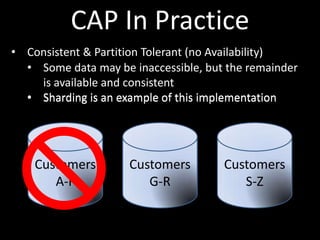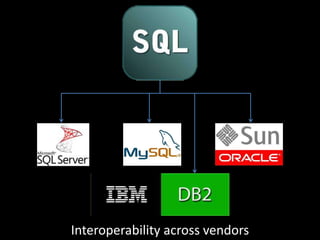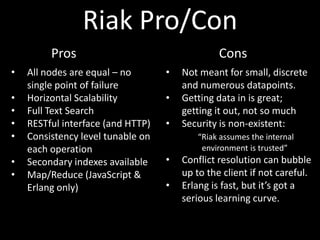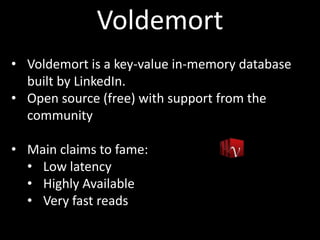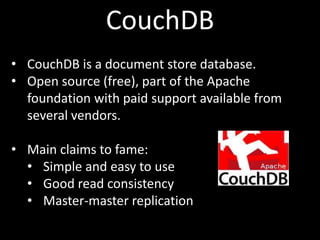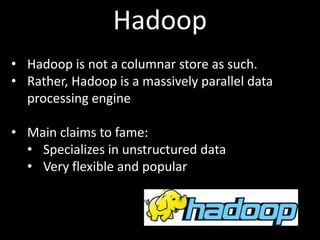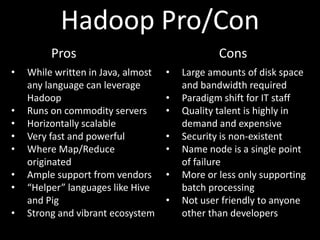Big Data Platforms: An Overview
- 1. Big Data Platforms: An Overview C. Scyphers Chief Technical Architect Daemon Consulting, LLC
- 2. What Is “Big Data”? • Big Data is not simply a huge pile of information • A good starting place is the following thought: “Big Data describes datasets so large they become very difficult to manage with traditional database tools.”
- 3. What Is A Big Data Platform? Putting it simply, it is any platform which supports those kind of large datasets.
- 4. It doesn’t have to be cutting edge technology.
- 5. Lots of legacy technologies can address the problem.
- 6. If only at a sizeable cost.
- 7. SQL Of the new technologies, the most promising are from the “NoSQL” family.
- 8. What Is “NoSQL”? SQL A family of non-relational data storage technologies
- 12. Usually with less cost than more traditional approaches.
- 13. Some of these technologies are new and innovative
- 14. Others have been around for decades.
- 15. NoSQL Does Not Mean “SQL Is Bad” When the trend was just starting, “NoSQL” was coined. It’s unfortunate, because it implies antagonism towards SQL.
- 16. NoSQL Means “Not Only SQL” RELATIONAL RELATIONAL NON- NoSQL is a complement to a traditional RDBMS, not necessarily as a replacement of them.
- 17. Why Won’t SQL Do?
- 18. Scale is very hard without ridiculous expense
- 19. SQL can get very complex, very quickly
- 20. Changing a schema for a large production system is both risky and expensive
- 21. Throughput can be a challenge
- 22. How Does NoSQL Do It?
- 23. Scale is achieved through a shared-nothing architecture, removing bottlenecks
- 24. Schemaless design means change becomes much less risky and significantly cheaper
- 25. Most solutions use simple RESTful interfaces
- 26. NoSQL is based upon a better understanding of data storage, usually referred to as the “CAP Theorem”
- 27. The CAP Theorem Grossly simplified (with apologies to Brewer): A database can be • Consistent (All clients see the same data) • Available (All clients can find some available node) • Partition-Tolerant (the database will continue to function even if split into disconnected sets – e.g. a network disruption) Pick Any Two.
- 28. CAP In Practice • Consistent & Available (no Partition Tolerance) • Either single machines or single site clusters. • Typically uses 2 phase commits
- 29. CAP In Practice • Consistent & Partition Tolerant (no Availability) • Some data may be inaccessible, but the remainder is available and consistent • Sharding is an example of this implementation Customers Customers Customers A-F G-R S-Z
- 30. CAP In Practice • Available & Partition Tolerant (no Consistency) • Some data may be inaccurate; a conflict resolution strategy is required. • DNS is an example of this, as well as standard master-slave replication
- 31. CAP From A Vendor POV • C-A (no P) – this is generally how most RDBMS vendors operate • C-P (no A) – this is how many RDBMS’ attempt to address scale without incurring large costs • A-P (no C) – this is how most NoSQL approaches solve the problem
- 32. ACID vs BASE Traditional Databases NoSQL Databases Tend Are ACID Compliant To Be BASE Compliant Atomicity – either the entire transaction Basically completes or none of it does Consistent – any transaction will take the Available database from one consistent state to another, with no broken constraints Isolation – changes do not affect other users Scalable until committed Durability – committed transactions can be Eventually consistent recovered in case of system failure Eventually consistent is the key phrase here
- 33. SQL Strengths Very well known technology
- 36. Large talent pool from which to choose
- 37. Ad hoc operations common, if not encouraged
- 38. NoSQL Strengths Built to address massive scale
- 40. While remaining highly available
- 41. And handling unstructured data
- 42. NoSQL Pros/Cons Pros Cons • Schema Evolution • Querying the data is • Horizontal Scalability much harder • Simple Protocols • Paradigm Shift • Security is a big issue • May or may not support data types (BLOBs, spatial) • Generally, uniqueness cannot be enforced
- 43. A Disclaimer Before We Continue • I am not an expert on every possible Big Data Platform • There are hundreds of them; these are the ones I consider the leaders in the field and recommend • If you have a favorite, please let me know and I’ll update the deck for next time • The internal details on how these systems work are rather complex; I would prefer to take those questions offline
- 44. Flavors Of NoSQL The major four divisions of NoSQL are: • Key-Value • Document Store • Columnar • Other
- 45. Key-Value • At a very high level, key-value works essentially by pairing a index token (a key) with a data element (a value). • Both index token and the data value can be of any structure. • Such a pairing is arbitrary and up to the developer of the system to determine.
- 46. A Key-Value Example “John Smith”, “100 Century Dr. Alexandria VA 22304” “John Doe”, “16 Kozyak Street, Lozenets District, 1408 Sofia Bulgaria” In both examples, the key is a name and the value is an address. However, the structure of the address differs between the two.
- 47. Document Store • Document stores extend the key-value paradigm into values with multiple attributes. • The document values tend to be semi-structured data (XML, JSON, et al) but can also be Word or PDF documents.
- 48. A Document Store Example “John Smith”, “<address><street>100 Century Dr.</street> <city>Alexandria</city> <state>VA</state> <postalCode>22304</postalCode> </address>” “John Doe”, “{ “address”: { “street”: “16 Kozyak Street” “district”: “Lozenets, 1408” “city”: “Sofia” “country”: “Bulgaria” } }”
- 49. Columnar Family • Usually has “rows” and “columns” • Or, at least, their logical equivalents • Not a traditional, “pure” column store • More of a hybridized approach leveraging key-value pairs • A key with many values attached
- 50. The Others • Hierarchical Databases • LDAP, Active Directory • Graph Databases • Neo4j, Flock DB, InfiniteGraph • XML • MarkLogic • Object Oriented Databases • Versant • Lotus Notes • HPCC (LexisNexis)
- 51. Key-Value Recap Pairing a index token (a key) with a data element (a value)
- 52. Key-Value Pro/Con Pros Cons • Schema Evolution • Packing & unpacking each key • Horizontal Scalability • Keys typically are not related • Simple Protocols to each other • Works well for volatile data • The entire value must be • High throughput, typically returned, not just a part of it optimized for reads or writes • Security tends to be an issue • Keys become meaningful • Hard to support reporting, rather than arbitrary analytics, aggregation or • Application logic defines ordered values object model • Generally does not support updates in place • Application logic defines object model
- 53. Where Did Key-Value Come From? The concept is quite old, but most people trace the lineage back to Amazon and the Dynamo paper.
- 54. Dynamo Amazon devised the Dynamo engine as a way to address their scalability issues in a reliable way. • Communication between nodes is peer to peer (P2P) • Replication occurs with the end client addressing conflict resolution • Quorum Reads/Writes • Always writable (Hinted Handoff) • Eventually Consistent
- 55. Eventually Consistent • Rather than expending the runtime resources to ensure that all nodes are aware of a change before continuing, Dynamo uses an eventually consistent model. • In this model, a subset of nodes are changed • Those nodes then inform their neighbors until all nodes are changed (grossly simplifying).
- 56. Can I Use Dynamo? No. It’s an Amazon only internal product. However, AWS S3 is largely based upon it. Amazon did announce a DynamoDB offering for their AWS customers. While it’s probably the same, I cannot guarantee that it is.
- 57. Riak • Riak is a key-value database largely modeled after the Dynamo model. • Open source (free) with paid support from Basho. • Main claims to fame: • Extreme reliability • Performance speed
- 58. Riak Pro/Con Pros Cons • All nodes are equal – no • Not meant for small, discrete single point of failure and numerous datapoints. • Horizontal Scalability • Getting data in is great; • Full Text Search getting it out, not so much • RESTful interface (and HTTP) • Security is non-existent: • Consistency level tunable on “Riak assumes the internal each operation environment is trusted” • Secondary indexes available • Conflict resolution can bubble • Map/Reduce (JavaScript & up to the client if not careful. Erlang only) • Erlang is fast, but it’s got a serious learning curve.
- 59. Riak Users
- 60. Redis • Redis is a key-value in-memory datastore. • Open source (free) with support from the community. • Main claims to fame: • Fast. So very, very fast. • Transactional support • Best for rapidly changing data
- 61. Redis Pro/Con Pros Cons • Transactional support • Entirely in memory • Blob storage • Master-slave replication • Support for sets, lists and (instead of master-master) sorted sets • Security is non-existent: • Support for Publish-Subscribe designed to be used in (Pub-Sub) messaging trusted environments • Robust set of operators • Does not support encryption • Support can be hard to find
- 62. Redis Users
- 63. Voldemort • Voldemort is a key-value in-memory database built by LinkedIn. • Open source (free) with support from the community • Main claims to fame: • Low latency • Highly Available • Very fast reads
- 64. Voldemort Pro/Con Pros Cons • Highly customizable – each • Versioning means lots of disk layer of the stack can be space being used. replaced as needed • Does not support range • Data elements are versioned queries during changes • No complex query filters • All nodes are independent – • All joins must be done in no single point of failure code • Very, very fast reads • No foreign key constraints • No triggers • Support can be hard to find
- 65. Voldemort Users
- 66. Key/Value “Big Vendors” • Microsoft Azure Table Storage • Oracle NoSQL • BerkleyDB (Oracle)
- 67. Document Store Recap Document stores store an index token with a grouping of attributes in a semi- structured document
- 68. Document Store Pro/Con Pros Cons • Tends to support a more • The entire value must be complex data model than returned, not just a part of it key/value • Security tends to be an issue • Good at content • Joins are not available within management the database • Usually supports multiple • No foreign keys indexes • Application logic defines • Schemaless (can be nested) object model • Typically low latency reads • Application logic defines object model
- 69. CouchDB • CouchDB is a document store database. • Open source (free), part of the Apache foundation with paid support available from several vendors. • Main claims to fame: • Simple and easy to use • Good read consistency • Master-master replication
- 70. CouchDB Pro/Con Pros Cons • Very simple API for • The simple API for development development is somewhat • MVCC support for read limited consistency • No foreign keys • Full Map/Reduce support • Conflict resolution devolves • Data is versioned to the application • Secondary indexes supported • Versioning requires extensive • Some security support disk space • RESTful API, JSON support • Versioning places large load • Materialized views with on I/O channels incremental update support • Replication for performance, not availability
- 71. CouchDB Users
- 72. MongoDB • MongoDB is a document store database. • Open source (free) with paid support available from 10Gen. • Main claims to fame: • Index anything • Ad hoc query support • SQL like operations (not SQL syntax)
- 73. MongoDB Pro/Con Pros Cons • Auto-sharding • Does not support JSON: BSON • Auto-failover instead • Update in place • Master-slave replication • Spatial index support • Has had some growing pains • Ad hoc query support (e.g. Foursquare outage) • Any field in Mongo can be • Not RESTful by default indexed • Failures require a manual • Very, very popular (lots of database repair operation production deployments) (similar to MySQL) • Very easy transition from SQL • Replication for availability, not performance
- 74. MongoDB Users
- 75. Document Store “Big Vendors” • Lotus Domino
- 76. Columnar Family Recap • A key with many values attached • Usually presenting as “rows” and “columns” • Or, at least, their logical equivalents
- 77. Columnar Pro/Con Pros Cons • Tend to have some level of • Is much less efficient when rudimentary security support processing many columns • Usually include a degree of simultaneously versioning • Joins tend to not be • Can be more efficient than supported row databases when • Referential integrity not processing a limited number available of columns over a large amount of rows
- 78. Where Did Columnar Come From? The concept has been around for a while, but most people trace the NoSQL lineage back to Google.
- 79. BigTable Google devised the BigTable engine as a way to address their search related scalability issues in a reliable way. • Data is organized through a set of keys: • Row • Column • Timestamp • A hybrid row/column store with a single master • Versioning is handled through the time key • Tablets are a dynamic partition of a sequence of rows – supports very efficient range scans • Columns can be grouped into column families • Column families can have access control
- 80. Can I Use BigTable? No. It’s a Google only internal product. However, quite a few open source products are built upon the concepts.
- 81. Cassandra • Cassandra is a hybrid of Big Table built on Dynamo infrastructure • Open source (free), built by Facebook with paid support available from several vendors. • Main claims to fame: • An Apache project • Very, very fast writes • Spans multiple datacenters
- 82. Cassandra Pro/Con Pros Cons • Designed to span multiple • No joins datacenters • No referential integrity • Peer to peer communication • Written in Java – quite between nodes complex to administer • No single point of failure and configure • Always writeable • Last update wins • Consistency level is tunable at run time • Supports secondary indexes • Supports Map/Reduce • Supports range queries
- 83. Cassandra Users
- 84. HBase • Hbase is a columnar database built on top of the Hadoop environment. • Open source (free) with paid support from numerous vendors • Main claims to fame: • Ad hoc type abilities • Easy integration with Map/Reduce
- 85. HBase Pro/Con Pros Cons • Map/Reduce support • Secondary indexes generally • More of a CA approach and not supported an AP • Security is non-existent • Supports predicate push • Requires a Hadoop down for performance gains infrastructure to function • Automatic partitioning and rebalancing of regions • Data is stored in a sorted order (not indexed) • RESTful API • Strong and vibrant ecosystem
- 86. HBase Users
- 87. Hadoop • Hadoop is not a columnar store as such. • Rather, Hadoop is a massively parallel data processing engine • Main claims to fame: • Specializes in unstructured data • Very flexible and popular
- 88. Hadoop Pro/Con Pros Cons • While written in Java, almost • Large amounts of disk space any language can leverage and bandwidth required Hadoop • Paradigm shift for IT staff • Runs on commodity servers • Quality talent is highly in • Horizontally scalable demand and expensive • Very fast and powerful • Security is non-existent • Where Map/Reduce • Name node is a single point originated of failure • Ample support from vendors • More or less only supporting • “Helper” languages like Hive batch processing and Pig • Not user friendly to anyone • Strong and vibrant ecosystem other than developers
- 89. Hadoop Users Plus lots, lots more
- 90. Columnar “Big Vendor” • EMC Greenplum • Teradata Aster In so far as both of these solutions are grafting Map/Reduce into a (more or less) SQL environment
- 91. Which One Do I Use Where? • Key-Value for (relatively) simple, volitile data • Document store for more complex data • Columnar for analytical processing • RBDMS for traditional processing – particularly where a lazy consistency is not acceptable • Point Of Sale, for example
- 92. Questions?
- 93. @scyphers Additional Information At http://www.daemonconsulting.net/BDC-FOSE-2012 Daemon Consulting, LLC http://www.daemonconsulting.net/ Specializing In The Hard Stuff





























